Introduction
The bigheaded ant (BHA), Pheidole megacephala (Fabricius), is a very successful invasive species that is sometimes considered a danger to native ants and has been nominated as among 100 of the "World's Worst" invaders (Hoffman 2006).
The BHA has been a pest in southern Florida for many years, and according to reports by pest control operators, has become the most pervasive nuisance as it has replaced other ants such as the red imported fire ant (RIFA), Solenopsis invicta Buren, and the white-footed ant Technomyrmex difficilis (Fr. Smith) in most areas. It is possible that the increase in BHA infestations was augmented by several years of excessive hurricane activity (2003 to 2005) in Florida that damaged lawns and killed trees, which necessitated the use of increased amounts of sod and other replacement vegetation that may have been infested with this ant (Warner, unpublished observation). In addition, it is thought that the BHA usually out-competes most other established ants, thereby dominating new areas. The BHA does not sting or cause any structural damage and usually does not bite unless the nest is disturbed, and even then, the bite is not painful. There are some 17 Pheidole species in Florida, of which 14 are native to Florida (Deyrup 2003).
The BHA, a soil-nesting ant, is sometimes confused with subterranean termites because it may create debris-covered foraging tubes that are somewhat similar, albeit much more fragile, than termite tubes. More often these ants leave piles of loose sandy soil. Homeowners are annoyed by these "dirt piles" and by ants foraging in bathrooms and kitchens and around doors and windows, as well as on exterior paved or brick walkways or driveways. Control of the BHA is difficult because the ant colonies are numerous, and populations usually extend across property lines.
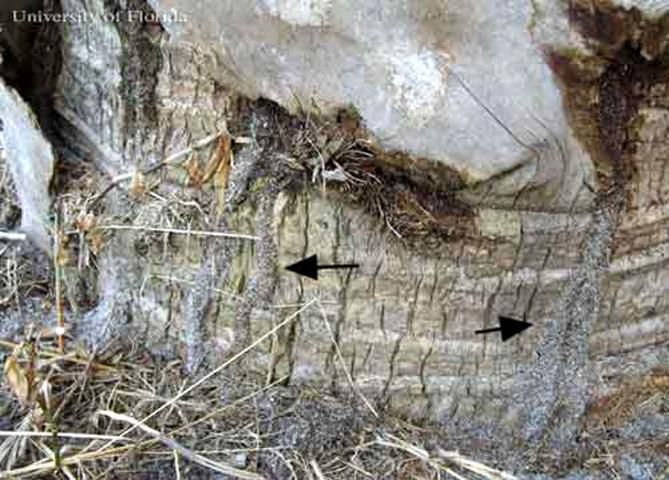
Credit: R. H. Scheffrahn, UF/IFAS

Credit: R. H. Scheffrahn, UF/IFAS
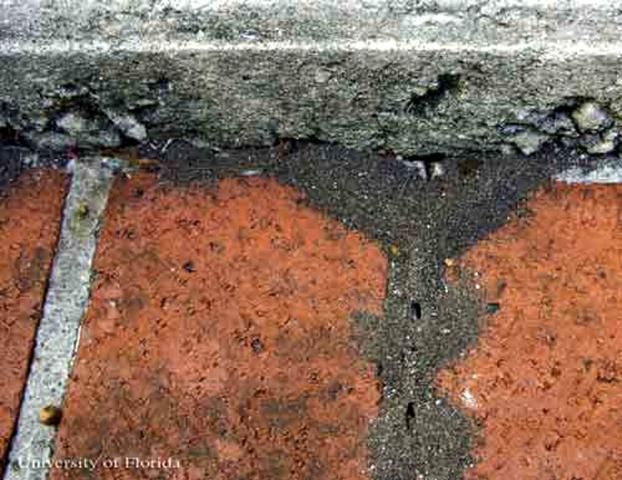
Credit: R. H. Scheffrahn, UF/IFAS
Distribution
Originally recorded from the Indian Ocean island of Mauritius (Fabricius 1793), the BHA is a widespread invasive tramp ant found in many subtropical and tropical regions throughout the world. Original reports of BHA in Florida mention the Everglades, Key West, and St. Augustine (Smith 1933).
More recently the BHA has been confirmed in Alachua, Brevard, Broward, Charlotte, Collier, Dade, Dixie, Highlands, Hillsborough, Indian River, Lee, Monroe, Palm Beach, Pinellas, Sarasota, Seminole, and Volusia Counties (Ferster et al. 2000, Deyrup 2003).
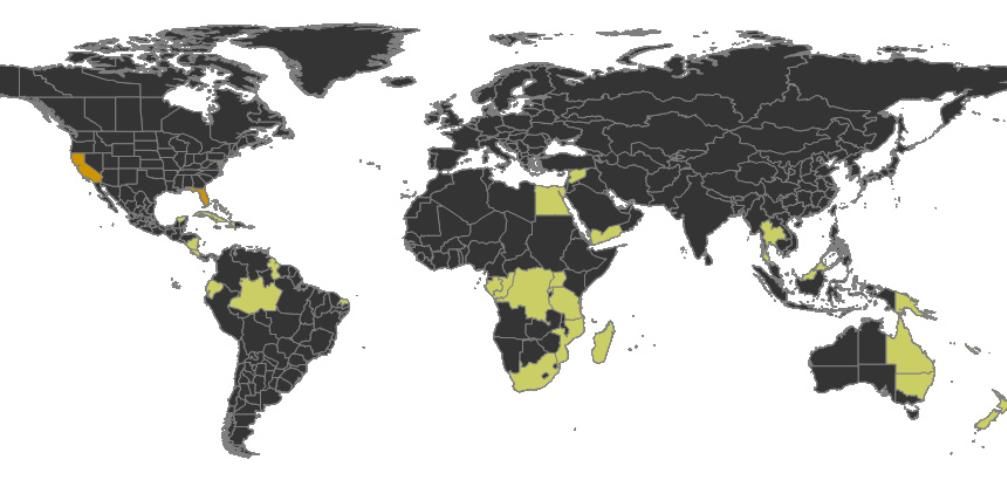
Credit: http://www.antwiki.org/wiki/Pheidole_megacephala#mediaviewer/File:Pheidole_megacephala_Distribution.png
Description
Workers are dimorphic (major and minor workers). The BHA receives its common name from the large-sized head of the major worker, or "soldier." Minor workers are small (2 mm) reddish-brown ants. The majors are much larger (3 to 4 mm) but only constitute about 1% of foragers. The front half of the major's head is sculptured, while the back half is smooth and shiny. The petiole (waist) of both worker forms is two-segmented, and the post-petiolar node is conspicuously swollen. The antenna is twelve-segmented with a three-segmented club. The entire body is covered with sparse, long hairs. Workers have a pair of short propodeal spines (spines on waist) facing almost directly upward. There is usually a dark spot on the underside of the gaster.
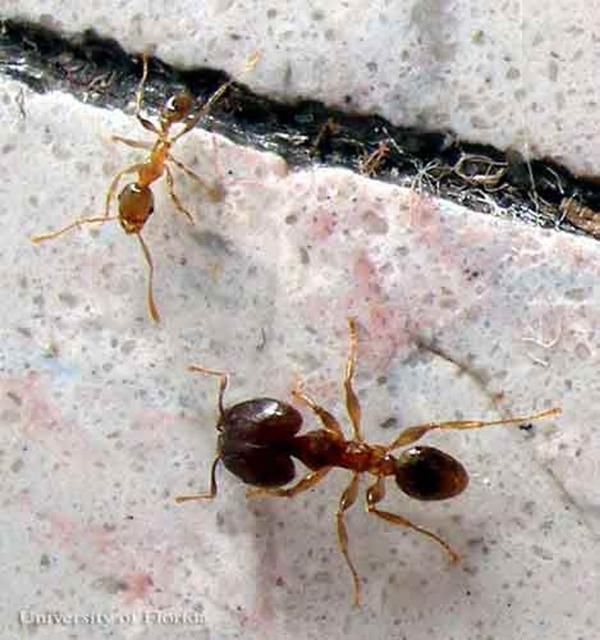
Credit: R. H. Scheffrahn, UF/IFAS
Similar Ants in Florida
The RIFA is sometimes confused with the BHA, but the RIFA has polymorphic (many sized) workers and the BHA is dimorphic. (See nest differences below.) When disturbed, the RIFA is highly aggressive and will bite and sting, while the BHA bites but does not sting. The BHA is slightly smaller, darker colored, and less shiny than RIFA. Both nest in the soil.
Life Cycle
As with all ants, the BHA has complete metamorphosis (holometabolous). Colonies can have large numbers of fertile queens (Wilson 2003) and year-round brood production in tropical and subtropical areas. In some areas, colonies can form a "virtually continuous supercolony that excludes most other ant species" (Wilson 2003). Although Vanderwoude et al. (2000) report that in Australia dispersal of new colonies is through budding without a nuptial flight, in south Florida nuptial flights of alates (winged reproductives) can be observed during the winter and spring (Scheffrahn, unpublished observations). Fertilized queens shed their wings and find a nest site where they will begin laying eggs.
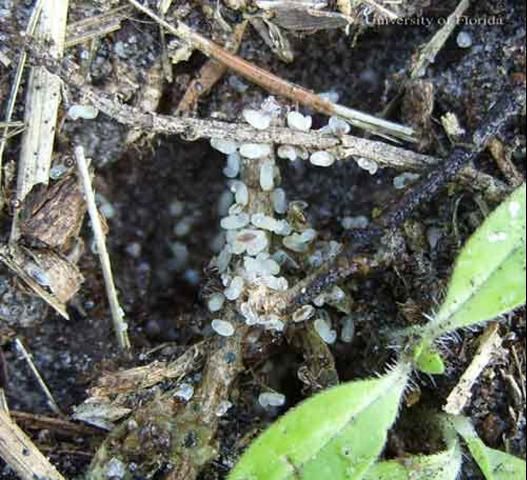
Credit: R. H. Scheffrahn, UF/IFAS
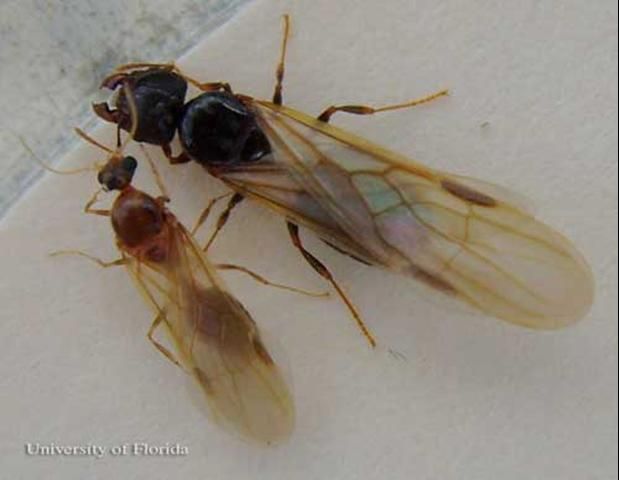
Credit: R. H. Scheffrahn, UF/IFAS
According to Hoffman (2006), incubation time of eggs ranges from 13 to 32 days. Duration of the larval stage ranges from 23 to 29 days. Duration of the pupal stage ranges from 10 to 20+ days. Life spans of minor workers have been shown to be 78 days at 21°C, and 38 days at 27°C. Queens are reported to lay up to 292 eggs per month.
Foraging and Feeding
The BHA is omnivorous, feeding on sweet liquids such as honeydews, dead insects, and soil invertebrates. Foragers will quickly recruit nest mates to a food source. Foraging tunnels having numerous entrances can be seen along the soil surface. Arthropod prey are dissected by workers and brought back to the nest.
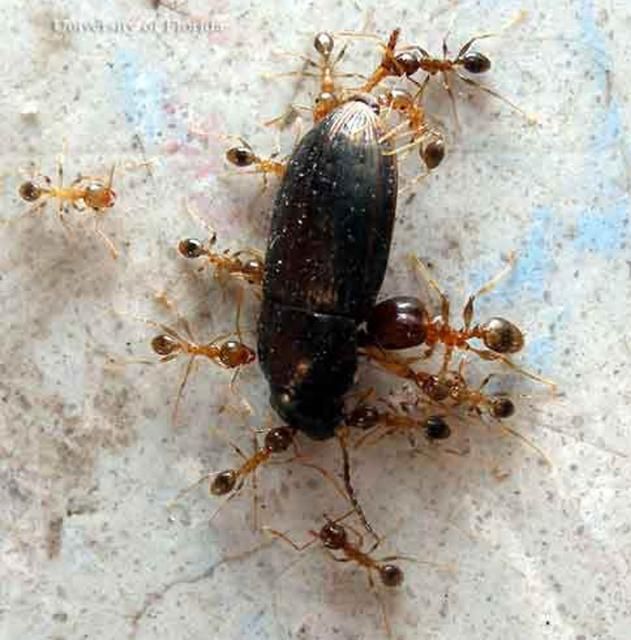
Credit: R. H. Scheffrahn, UF/IFAS
Trails of foragers can often be observed along tree trunks, sometimes climbing into canopies of tall trees. Similar trails might be seen on the exterior walls of structures as ants climb into attics or other natural or artificial voids.
Trophallaxis (an exchange of food between ants) is frequently observed between two minor workers, or a minor and major worker.
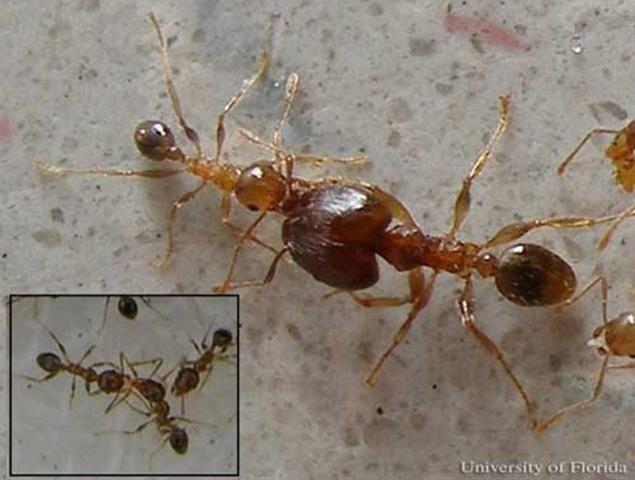
Credit: R. H. Scheffrahn, UF/IFAS
Nest Sites
The BHA can be found nesting in disturbed soils, lawns, flowerbeds; under objects such as bricks, cement slabs, or flower pots; around trees or water pipes; along the base of structures; and walkways, where displaced soil is usually observed from the action of ants digging below the surface. Well-cared-for lawns may have BHA infestations that are less noticeable, except along the edges where lawns meet walkways where piles of soil are often deposited. BHA populations expand into neighboring areas by following along these lawn-walkway edges or roadways. Population movements into new areas to establish nests and subsequent displacement of other ant populations can be rapid (Hoffman 2006; Warner, unpublished observations).
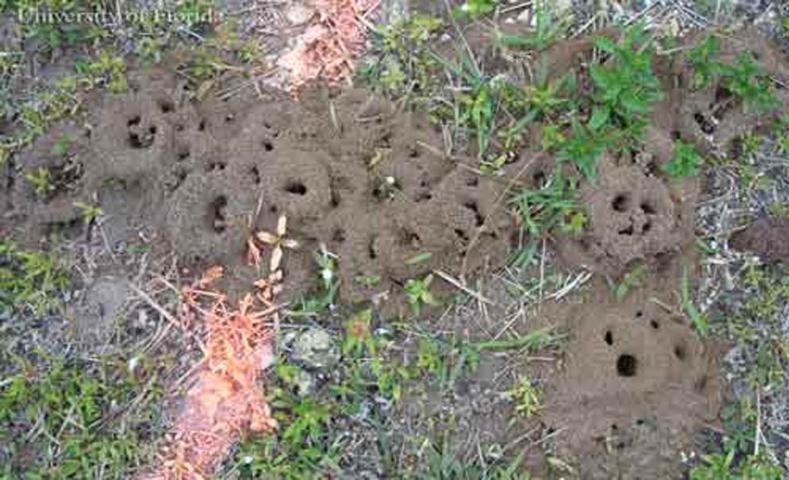
Credit: J. Warner, UF/IFAS
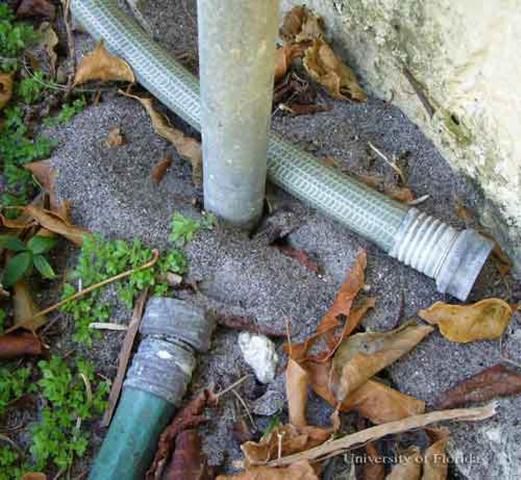
Credit: J. Warner, UF/IFAS
Nests of RIFA are similar to those of the BHA. Careful observations will distinguish either the larger major workers of the BHA, or, if the nest if RIFA, polymorphic aggressive ants will emerge from the nest after a slight disturbance.
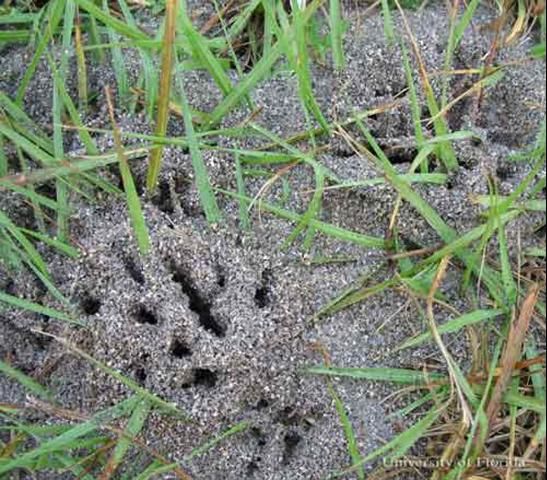
Credit: J. Warner, UF/IFAS
Pest Status
In 1995, a survey of the pest ants of Florida (Klotz et al. 1995) reported these eight species as having the highest percentages of customer calls to pest control companies:
-
Red imported fire ant, Solenopsis invicta Buren—14%
-
Ghost ant, Tapinoma melanocephalum (Fabricius)—14%
-
Crazy ant, Paratrechina longicornis (Latreille)—14%
-
Florida carpenter ant, Camponotus floridanus (Buckley)—12%
-
Pharaoh ant, Monomorium pharaonis (Linnaeus)—11%
-
Tortugas carpenter ant, Camponotus tortuganus Emery—8%
-
bigheaded ant, Pheidole megacephala (Fabricius)—7%
-
Paratrechina bourbonica (Forel)—4%.
A new survey of pest ants in Florida has not been done, but at least in southeastern Florida, the white-footed ant can be added, and the status of the BHA has increased. Perhaps the order of the top nine most problematic pest ant species in and near structures (South Florida 2007) might be:
-
Bigheaded ant
-
White-footed ant, Technomyrmex albipes (Fr. Smith)
-
Ghost ant
-
Red imported fire ant
-
Crazy ant (Paratrechina spp.)
-
Florida carpenter ant
-
Tortugas carpenter ant
-
Pharaoh ant
-
Rover ant, Brachymyrmex spp.
Management
At present, pest control companies are using residual spray products containing fipronil, bifenthrin, or permethrin, sometimes in conjunction with granular baits. Lawns and flowerbeds are sometimes treated with granular insecticides containing fipronil or lambda-cyhalothrin. I have found permethrin to be ineffective for BHA (Warner, unpublished observation).
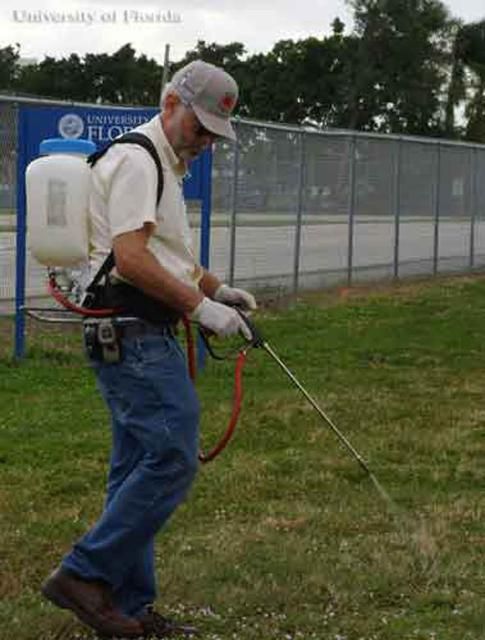
Credit: R. H. Scheffrahn, UF/IFAS
In an experiment against BHA performed at the UF/IFAS Fort Lauderdale Research and Education Center (UF/IFAS FLREC), two residual products tested provided some degree of control for about 2 weeks: Transport (27% bifenthrin, 23% acetamiprid) and Arena (50% clothianidin). Two of the baits tested in this experiment provided control up to about 4 weeks: Siesta (0.063 % metaflumizone) and MaxForce (0.0005% fipronil).
Further testing might include baits that contain an insect growth regulator, such as Extinguish Plus (hydramethylnon 0.365%, S-methoprene 0.250%). In one experiment, a methoprene bait was found to be effective in reducing a BHA population (Lee et al. 2003).
Whichever products are eventually determined to be the most effective in controlling this pest ant, it seems imperative that treating lawns, ornamental areas, and disturbed soils be included in any pest control program. Pest control companies doing residential perimeter treatments must have supplemental applications done to the lawns, flowerbeds, around trees, along walkways and on driveways made of bricks. To obtain adequate coverage, using a truck-mounted "power-sprayer" for residual pesticides is suggested. The senior author has spoken to numerous lawn treatment companies, and it seems to be a universal policy that ants are not considered to be pests of lawns, and these companies will not make treatments for BHA. Even so, because ants are, after all, insects, insecticidal treatments to lawns will most likely have an impact on the ant populations. Because this ant reproduces so prolifically, and nest sites are often protected by being under objects, lawns and flowerbeds will probably need to be treated at least four to five times per year at maximum label rates. One-time treatments for the BHA will be of very limited value.
BHA entering into structures can be baited with sweet liquid-based ant baits, insecticidal gels, or sprayed with a residual insecticide, always in conjunction with treatments to the exterior of the structure as mentioned previously. Ants nesting in wall voids can be treated with insecticidal dusts or foams, or with baits placed near void entrances.
Baiting programs can sometimes take several weeks for significant population reductions (Warner et al. 2008). Residential properties adjoining infested properties of neighbors necessitate cooperation in order to control the infestation. When properties border unoccupied infested areas, often the homeowners' association will need to be contacted to arrange treatments for those areas. It should be stressed that if infested properties adjoining the property being treated are not also treated, ants will quickly enter and reinfest the treated property. Without area-wide control treatments, local retreatments are to be expected.
Note: for all insecticidal treatments, always follow label directions!
Selected References
Creighton WS. 1950. The Ants of North America. Bulletin of the Museum of Comparative Zoology 104. 585 p.
Deyrup M. (2003). An updated list of Florida ants (Hymenoptera: Formicidae). Florida Entomologist 86: 43–48. https://journals.flvc.org/flaent/article/view/75168/72826 (24 February 2022).
Fabricius JC. 1793. Entomologia Systematica Emendata et Aucta. Secundum classes, ordines, genera, species. Adjectis synonimis, locis, observationibus, descriptionibus. Hafniae: C.G. Proft 2 viii. 519 pp.
Fasulo TR. (2002). Cockroaches and Pest Ants. Bug Tutorials. University of Florida/IFAS. CD-ROM. SW 157.
Fasulo TR, Kern W, Koehler PG, Short DE. (2005). Pests In and Around the Home. Version 2.0. University of Florida/IFAS. CD-ROM. SW 126.
Ferster B, Deyrup M, Scheffrahn RH. (2000). The pest ants of Florida. http://flrec.ifas.ufl. edu/entomo/ants/Pest%20Ants%20of%20FL/index.htm (23 January 2007).
Hoffman B. 2006. Pheidole megacephala (insect). CSIRO Sustainable Ecosystems. Global Invasive Species Database. http://www.iucngisd.org/gisd/species.php?sc=132 [24 February 2022].
Klotz JH, Mangold JR, Vail KM, Davis Jr LR, Patterson RS.1995. A survey of the urban pest ants (Hymenoptera: Formicidae) of peninsular Florida. Florida Entomologist 78: 109–118.
Lee CY, Lee LC, NA JPS, Loke PY, Lim KT, Teo EHH. 2003. Evaluation of methoprene granular baits against foraging Pharoh ants, Monomorium pharaonis (Hymenoptera: Formicidae.) Sociobiology 41: 717–723.
Smith MR. 1933. Additional species of Florida ants, with remarks. 17: 21–26.
Vanderwoude C, Lobry De Bruyn LA, House APN. 2000. Response of an open-forest ant community to invasion by the introduced ant, Pheidole megacephala. Austral Ecology 25: 253–259.
Warner J, Yang R-L, Scheffrahn RH. 2008. Efficacy of selected bait and residual toxicants for control of bigheaded ants, Phedole megacephala (Hymenoptera: Formicidae), in large field plots. Florida Entomologist 91: 277–282
Wilson EO. 2003. Pheidole in the New World, a Dominant, Hyperdiverse Ant Genus. Harvard University Press. Cambridge, MA. 794 p.